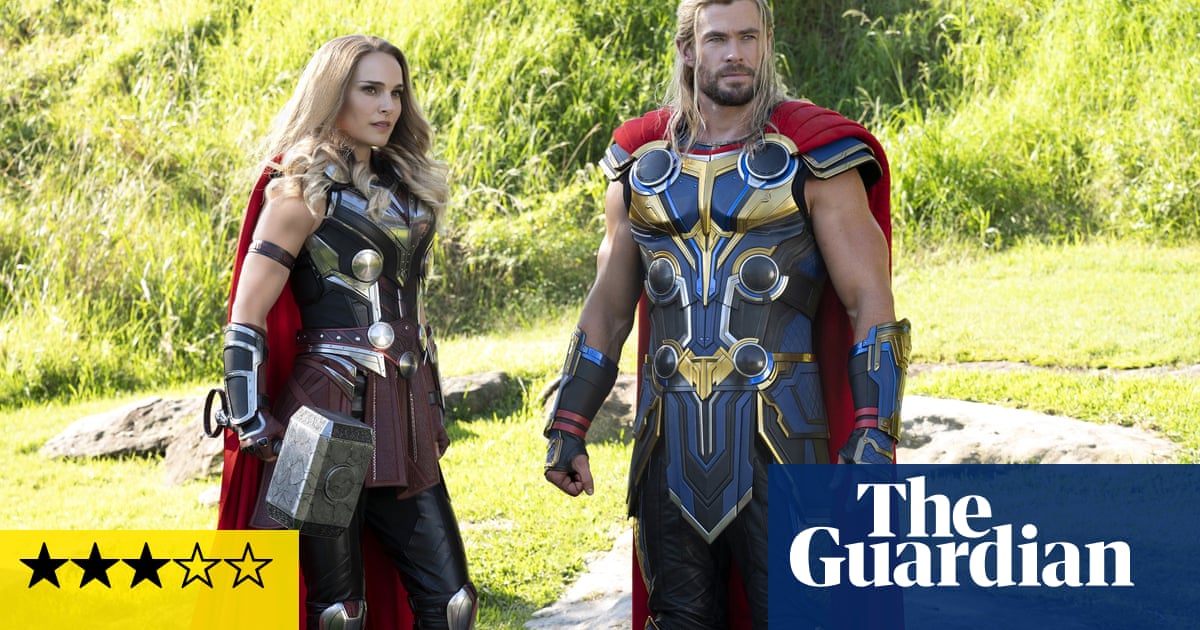Thor’s Follow-up: Ragnarok repeats some of the irony of this masterpiece when Natalie Portman’s Jane Foster takes over the tasks of launching tools.
In 2017, Taika Waititi directed Thor: Ragnarok, which is still the most productive film of the MCU, and a few years before, the very good vampire that ignites the franchise What We Do in the Shadows: or comic gold and a lot. more wonderful than his misjudgment and the exaggerated Nazi satire of the Panzer-crash Jojo Rabbit. Now, Waititi has directed and co-written with Jennifer Kaytin Robinson, an entertaining sequel to her MCU masterpiece. Like the first film, it’s an ironic cosmic showing in Mike Hodges’ Flash Gordon culture, with some wonderful gags, big cameos (though I missed some of the main characters in Thor: Ragnarok) and Chris Hemsworth returning to offer his casual turn as a wonderful Norse god with linen hair. And of all the Hollywood movie stars who lately take the Shilling of the MCU, Hemsworth is the uninhibited maximum, the maximum who visibly has fun, the maximum absolutely at ease in his own skin and in front of his own green screen.
In this episode, Thor will have to face the evil Gorr, the mason god, played through Christian Bale, who, with his terrifying necro-sword, kills the deities of the tent for a feeling of bitterness because the gods once allowed his little daughter to die. First of all, Thor discovers himself fighting alongside the Guardians of the Galaxy, who are his tonal equivalents in Marvel’s now well-established comedy mode, but recruits his own team to fight Gorr when this supervillain kidnaps all the young men of New Asgard. His new team includes Valkyrie (Tessa Thompson) and Korg (played through Waititi himself), as well as his former and now ex-love (their breakup outlined in a romantic comedy-style flashback). This is Dr. Jane Foster, played through Natalie Portman, suffering from a serious illness that has subsided thanks to the harsh cosmic powers of Thor’s once damaged hammer, Mjölnir.
The must-have stupidity of everything that happens is well embodied through Hemsworth, though the film now takes a more solemn approach to Dr. Foster’s cancer and references to his chemotherapy. The film is probably on its most powerful floor with the ultimate purely absurd touches, such as the rivalry between the hammer Mjölnir and his new weapon, the Punch Stormbreaker, which piles into the frame suspiciously when Thor begins dating Mjölnir, unable to settle for Mjölnir being with Dr. Foster now. Thor himself has triumph over his weight disorders and is now a charming alpha-male figure who literally causes the young goddesses to faint in a scene after he undresses and reveals to them his virility (or rather his divinity).
The film is really governed by a cameo, the figure of Zeus, which would be unsportsmanlike to reveal here: our guest star A-list shows one of his strangest accents to date, but he also laughs a lot, because the next Thor deprives him. of its lightning. And yet, it will have to be said that, despite the dexterity with which Waititi plays it, Marvel’s comedy mode has become a reflection, a quick mode that can almost be activated in the settings menu of the Marvel software. – a very contained form of self-restriction. satire or self-degradation that is compensated through the huge CGI intergalactic action scenes. It turns into a bit of a dead ending, but that doesn’t mean it’s not fun, and Thor offers a hard hammer blow, or rather a lezna shot, fun.
Thor: Love and Thunder is july 6 in Australia, July 7 in the United Kingdom and July 8 in the United States.

